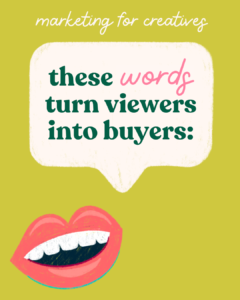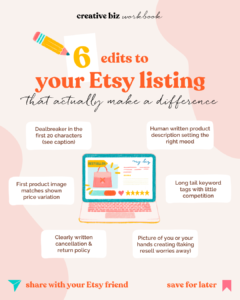Let’s talk about something that often gets a bad rap in our creative circles: branding.
Hold on, don’t close this page just yet.
I know some of us see it as too “corporate” or fake, but trust me when I say that having a brand is actually a good thing.
In fact, it can be a game-changer for your business, especially in a market crowded with factory-made and “print on demand” products.
It can help you stand out from these saturated markets and reach buyers that are looking for authentic work – your buyers.
First off, let’s quickly clarify what a brand really is.
It’s not just a fancy logo or a catchy name.
A brand encompasses your visual identity, your story, and the purpose and value your product carries. It’s a way to communicate who you are, what you stand for, and what sets you apart from the competition.
When done authentically, a brand becomes a powerful tool that helps you connect with your audience on a deeper level.
Stand out as an authentic maker
Now, back in the early days of my artistic career I used to be skeptical about branding myself. I believed it was something only big corporations needed to worry about and that having a brand would make me some kind of sell-out in the creative/indie world.
But over time, I realized that having a brand is not about being fake, too business-y, or conforming to a certain image.
It’s about understanding who you are as an artist or maker and sharing that with the world.
Your brand is a way to express your unique style, your values, and the emotions you want your buyers to feel when interacting with your work.
Having a strong brand is especially crucial if you want to turn your creative passion into a full-time income.
In today’s competitive e-commerce landscape, where there are hobbyists and wholesalers offering similar products at lower prices, standing out becomes even more challenging.
This is where your brand becomes your secret weapon.
By having a well-defined brand, you know exactly who your target customers are. You can tailor your messaging, your visuals, and your overall presence to attract and resonate with the people who are most likely to love and buy your creations.
“In a sea of options, a strong brand helps you create a connection with your audience and convinces them that you are the best choice.”
Your brand is what makes you stand out amidst the flood of factory-made and generic print-on-demand products.
The audiences for handmade goods and mass-produced items are different, and your brand helps the right audience find you.
While someone might be satisfied with a generic print-on-demand sweater, there are people out there who seek out the unique, the personal, and the artistry of handmade.
Your brand becomes the guiding light that leads them to your doorstep.
Scaling
But branding isn’t always just about attracting fans and buyers —it’s also about scaling up your business.
As artists and makers, there’s only so much we can produce by hand. If we want to increase our income and grow our businesses, we need to find ways to add value.
By investing in your brand, you can elevate the perceived value of your offerings and justify higher price points. This opens up opportunities to sell fewer products at higher prices, resulting in increased profitability.
Consider this: a beautifully packaged product with thoughtful branding and attention to detail can command a higher price compared to a similar product without any branding.
It’s all about the perceived value.
By investing in your brand, you can communicate the quality, craftsmanship, and uniqueness of your handmade creations.
Now, I understand that adding value through branding might seem challenging for certain handmade items. However, there are various approaches you can take.
Adding value
Start by improving your product photography. High-quality, well-lit images can instantly elevate the perceived value of your creations. Invest time in learning about photography techniques or consider hiring a professional photographer if it’s within your budget.
Additionally, think about the overall presentation of your products. Can you create unique and eye-catching packaging? How about including a handwritten note or a small bonus gift with each purchase? These small touches add an extra layer of care and value that customers appreciate.
Telling your story
Another powerful aspect of branding is storytelling. Share the story behind your brand and products. People love to connect with the artists and makers behind the creations they purchase.
By telling your story, you create a personal connection with your customers, making them feel more invested in your brand and more willing to support your business. Whether it’s the inspiration behind a particular collection or the techniques you use to create your pieces, let your audience get to know the heart and soul of your brand.
Positive experience
Exceptional customer service is another crucial component of branding.
Providing a positive and memorable shopping experience can significantly enhance your brand’s reputation. Respond promptly to inquiries, package your products with care, and follow up with customers to ensure their satisfaction. Happy customers not only become repeat buyers but also become brand advocates, spreading the word about your exceptional products and service.
Embrace branding as a tool to express your unique style, connect with your audience, and add value to your offerings. Your brand is an invitation for customers to step into your creative world and experience the magic you bring to their lives.
Handmade still matters, and in a world filled with automated processes and print-on-demand sites, it is more precious and essential than ever.
Brand your original handmade work in a way that resonates with people seeking authenticity and craftsmanship.
Let your brand be the beacon that guides them through the noise of mass production and leads them to the meaningful and personal connection they desire.
Embrace your brand, share your story, and watch as your business flourishes in the crowded marketplace.







